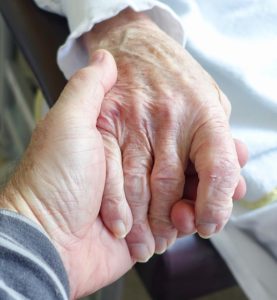The Human Connection Model for memory care
“Contemporary advocates for nursing home reform (Fagan, Williams, & Burger, 1997) contend that quality of life for nursing home residents will improve only when their lives are more like life in the world outside.” (Ronch & Goldfield, 2003)
This paper summarizes the Human Connection Model, as organized by Pamela Silberman-Mills, with the influence of proven person-centered philosophies including: The Montessori Method for Positive Dementia Care (Brenner, 2012); Dementia Capable Care: A Best Abilities Approach (CPI, 2008); and The Best Friend’s Approach for Alzheimer’s Care (Troxel and Bell, 2004). Additionally, “The Six Essential Senses” have been adapted from Daniel Pink’s book A Whole New Mind (Pink, 2005), for use within a dementia experience model with Daniel Pink’s written permission. The purpose of this paper is to summarize the scope of the Human Connection Model and its best practices.
 The Human Connection Model asks every aging services practitioner to intentionally and creatively take part in the older adult’s current experience. Together they draw out each person’s lifetime values and expertise, co-designing the caregiving. Appreciative of the fact that each person is an expert within his or her own life, the Human Connection model highlights the key elements of: Individual Choice, Community Ownership, Sustaining Kinship, Employing Expertise and Integrative Wellbeing.
The Human Connection Model asks every aging services practitioner to intentionally and creatively take part in the older adult’s current experience. Together they draw out each person’s lifetime values and expertise, co-designing the caregiving. Appreciative of the fact that each person is an expert within his or her own life, the Human Connection model highlights the key elements of: Individual Choice, Community Ownership, Sustaining Kinship, Employing Expertise and Integrative Wellbeing.
Why focus on connection?
Multiple researchers agree (Theurer et al., 2016)(Tomaka et al., 2006)(Sorkin, 2002)(Medvine, 2015)(Zhong et al., 2016) that the need for emphasizing human connection is essential for our physical and emotional health, boosting strength and healing during disease processes. Dementia is a disease of accumulating losses. In essence, through its stages, we lose our ability to connect with and express our personhood. Over time the self we and our loved ones once intimately knew appears to slip into the shadows—still perceived, but able to be articulated indirectly with limited recognition. The disease causes many to sacrifice their memories, social relationships, comforts of home and financial assets. Further in the disease process, the person relies on others to eat, bathe, dress, administer medicine and maintain relationships.
Consumers of the U.S. healthcare system have voiced concern over the difficulties of being “just another number” in the mass provision of healthcare services (BoozAllen Hamilton, 2014). The central priorities of the “medical model” (also known as an “Institutional model”) of dementia care were to “keep residents clean, dry, safe and quiet” (Warchol, 2008). With limited emphasis on an individual’s value and emotional wellbeing, this model confined passive care receivers who were not just lost in the system, but lost in themselves.
Some of the basic needs of childhood are love and emotional connection. When we receive these, we learn to feel worthy and lovable. At any age, social isolation leads to loneliness, depression and poor health. Therefore, by creating a connected community, focusing its daily pulse on supporting a person’s intimate needs for being known as their best self, we alleviate one brutal symptom and soften the disease.
How is “connection” defined within the Human Connection Model?
Humans are connected beings. We seek and thrive upon relationship from conception to cessation. Our relationships transpire privately and publicly, within our family, friendships, work and cultural environments. We reflect these connections through our choices, opinions, preferences and associations. We articulate them by the words we speak, the silence we keep or the behavior we express. This differentiation is the practice of who we are. The Human Connection Model recognizes these components of connection within each person’s vital identity and creates a community pulse around it.
Symbolism of the conch shell
The Human Connection Model adopts a conch shell as its symbol, as this type of shell represents multiple aspects of personhood and the journey of dementia. The conch shell contains both coarse and smooth components, albeit one. On the surface, the observer may assume he or she knows all that exists in a person’s self. Yet, not one of us has seen the entire journey. Some may only get a glimpse if we use our time together to deeply listen. As a caregiver commits to traveling with the person experiencing dementia, he or she may discover an endless pathway of untold grottoes that may at first appear convoluted, but also could reveal smoother sides. The Human Connection Model centers itself on providing a safe space for this profound exploration. Over time, there may be areas that remain hidden; yet, each revelation is still a valuable component of the whole.
The Six Heart Strings of affective care
Just as a guitar has six strings that individually and collectively enhance the song, the Human Connection model has Six Heart Strings that lead the way towards providing more affective care within a community that includes persons with dementia. Each one of these ‘strings’ is a necessary component for the community to be in tune with all persons. Adapted from “The Six Essential Senses” named within Daniel Pink’s book A Whole New Mind (Pink, 2005), a brief summary of these Six Heart Strings and how they relate to creating an experience of wellbeing for caregivers and care receivers is as follows:
1. Design: By consciously facilitating a physical and relational environment that encourages personal expression, development and natural engagement, we strategically design public and private spaces with a layout that motivates a person’s inclusion, best abilities and individualism. We give rise to exploration and purposeful engagement. Curiosity is natural, as is the desire to investigate, reminisce and discover. Our environment seeks to encourage exploration without fear or restriction.
2. Story: Inquiring about, utilizing and honoring a person’s unique preferences, history and ways of perceiving his or her life experience are just a few of the ways that story can be integrated into a dementia-friendly environment. We identify how the person is narrating the situation at hand and adjust our actions to collaborate with their perception.
3. Symphony: We can recognize that each person in the care partnership has an individual voice or “note” that benefits the whole. We apply an integrative thinking approach to the ways we interact, and the care partners mold a peak experience from one another’s best abilities. Each interchange is a flow of contributing ideas for leading and following. The rhythm of life is written together, and the community learns to listen for the notes, molding into a song what once may have been heard as mere noise.
4. Empathy: Together we model a respectful understanding of the feelings, challenges and changes others are experiencing. Intentionally leaving our judgments at the doorway, we provide a foundation for our connection through trust and active listening. We create a safe space for one another’s authentic expression and vulnerability, welcoming discomfort, contentment and grief without minimization or denial.
5. Play: To inspire play is to welcome self-expression. Abundant data identifies the enormous health benefits of laughter, lightness, games and humor. In an environment serving persons with dementia, play helps lessen barriers of all types: communication, emotional, cognitive and social just to name a few. There is an intrinsic grace in play that allows for tasks to be undertaken with a mode of welcome levity over tense structure, helping the experience to be less stressful and fearful for every person involved.
6. Meaning: Knowledge is nothing without meaning. Objects, tasks, relationships and activities within an environment have no purpose or pull except for the meaning we give to them; which is why a person can be sitting within a room filled with people and still feel lonely. Without the meaning we give to each day, it cannot be considered successful or dynamic. The desire to be a productive member of society remains within each human being. This draw is the same for persons with dementia. We strive to make each day meaningful with each person, intentionally taking time to discover avenues where he or she can contribute with purpose.
The environment of the Human Connection Model
“Design is interdisciplinary… learning to bring disparate things together to a solution. Design is the human nature to shape our environment in ways that serve our needs and give meaning to our lives.” –Daniel Pink, 2005
Think of an apartment complex as an example of group habitation. Each resident has his or her individual residence, which although identical in structural layout, wholly differs from every other occupant. Enter into each home and you discover a tangible expression of that person’s life. Most likely, every object has a story or meaning attached—they are not idle things, but memories and representations of each person. The Human Connection Model emphasizes design as one of the Six Heart Strings for affective care strategically fashioning the layout of the group household [public spaces] and person’s individual room [private spaces] to be a reflection of each individual.
When creating temporary or long-term environments for people with dementia, it is essential for planners to realize that each community is much more than the physical surroundings. This is a person’s home, no different than any other standard home—except for its inclusion of caregiving support. The Human Connection Model purposefully places memories within the older adult’s environment and not mere objects. A meaningfully designed environment contains photographs and artwork that tell a story and engage conversation, has pleasing scents (from food preparation or aromatherapy) and sounds that calm, inspire or invigorate, and has additional motifs that encourage each person to feel safe, understood and completely at home. The public space becomes a reflection of each participant’s life, with cues provided from residents and family members. For example, if John collected foundry iron mechanical banks, one or two of these banks are placed on the shelves of the living room, waiting for John and perhaps other participants to share their memories about them. Similar intentional placements are accomplished with photos (for example, a travel photo of where Marge and her husband honeymooned) and other interior cues. Here the environment becomes an extension of the individual, not leaving the person with dementia to be a “stranger in a strange land.
Every person has a story
“Narrative imagining—story—is the fundamental instrument of thought… most of our experience, our knowledge and our thinking is organized as stories.” –Mark Turner, The Literary Mind
The Human Connection Model places each person’s story front and center within the rhythm of life, not solely because stories define the essence of who we are, but also because stories are the ways we connect to the outside world from our own inner picture. Our stories are our bridge to meaning behind each passing instant and weave a pattern of deeper memories from moment to moment. Since dementia affects the part of the declarative memory system where we store facts and common knowledge, a person may not be able to define an object by any idea other than their identified story about the object. For example, a person with mid-stage dementia may not be able to tell you the name of the neighbor, the location or the acreage of the farm near his childhood home; however, he can speak for 30 minutes about the way the farm animals looked, smelled and felt as he recalls the story of walking through the fields when a goat surprisingly nibbled lightly on his pant leg.
The Human Connection Model has care partners emphasize stories and preferences over facts or sterile tasks because these connections are the means that allow each person with dementia to take ownership of each moment within their current environment. For example, James’ nursing aide knows that it is much easier for him to get “just right.” The aide shows him the shoes first and asks him if he is ready to get dressed. Seeing the shiny shoes helps James connect with rising each morning to the sound of the bugle and he does not want to be late.
Valuing a person’s story about an experience will alleviate fear in unfamiliar settings or routine. The care partnership accomplishes success by focusing on the expressive memory hidden within each moment and not on the overwhelming stimuli that a person can’t relate. Imagine the response when Mrs. Smith pushes away her dinner plate because she cannot recall why she is at the table, but then hears: “Ms. Smith tell me about the desserts you made for your son John—You do like to bake, right?” Mrs. Smith still may not eat, but she won’t feel lost at the table.
One specific use of story in the Human Connection Model is the inclusion of a personalized story binder for each person with dementia within the library of the public space. Resembling decorative scrapbooks, created with help from a person’s family and friends, the binders contain detailed biographies, preferences and descriptions of their treasured interests and memories with the use of audio, visual and tactile imagery. The binder becomes an essential tool, reviewed daily in staff meetings and in times when the person with dementia is experiencing distress. These binders encourage comfort and dialogue.
A person with dementia or memory loss continues to retain all aspects of his or her personhood (needs, values, world view, culture, emotions, creative drive, curiosity, ideas, etc.). Knowing the stories fueling these aspects of personhood, allows us to more intimately care for each other—connecting more deeply with greater understanding. The story may also create a bridge for self-expression when the use of words may become more encumbered due to progressing symptoms of dementia. Pain and fear can restrict a person’s ability to communicate, add memory loss to the mix and people are left with limited options for articulating the call for assistance that he or she may desperately need—leading to alternative or desperate expressions often termed as “behaviors.” Building a relationship through a welcoming, connected environment, prior to and through these challenges helps ease frustration overall—allowing residents to feel more safe, understood and loved, even when words are not immediately available.
The Five Values of the Human Connection Model
A community that fosters individual and social wellbeing helps humanity thrive. As noted by Drs. Abraham Maslow and John W. Travis, both mental and physical health is intricately linked to meeting a detailed hierarchy of needs. The Five Values of the Human Connection Model arose out of recognizing the most essential components of a person-centered framework that not only promote the strengths of each person who has a dementia related condition; but also, foster mutual well-being within a collective construct.
The Five Values of the Human Connection Model are:
- Individual choice
- Community ownership
- Sustaining kinship
- Employing expertise
- Integrative wellbeing
Individual choice
“People who believe they have the power to exercise some measure of control over their lives are healthier, more effective and more successful than those who lack faith in their ability to effect changes in their lives.” –Albert Bandura
Without choices every person is powerless. Worse in the system of dementia services, as long as choice is withheld from a person with dementia, the caregiver or facility (Author’s Note: I use this word unambiguously) is once more emphasizing loss on a comprehensive level. A forfeiture of choice and daily practice of powerlessness was the core component of the institutional model. Under the assumption that staff knew best, offering a patient choice was perceived to be overwhelming, unstructured and wasteful of staff time. Patients within the institutional model were considered to be incapable of choice; therefore, not offering options was viewed as better for their welfare. However, when does it ever feel good to be told what to do, when and how?
Carl Rogers, noted “Father of Humanistic Psychotherapy” stated “individuals are architects of their own lives,” noting that each person’s experience is the highest authority for that person. Rogers taught psychotherapists the importance of offering unconditional positive regard and a growth promoting climate to clients. The same congruence of respect is necessary for persons with dementia. Each person, no matter the presence of disease, deserves the opportunity to make a choice and consequently change their mind—to not have such an opportunity is collectively defined as prison.
When a community practices individual choice as a daily value through the Human Connection Model (similar to Carl Rogers and his clients), care partners develop trust and unconditional positive regard. Respect is then understood as the way of life, empowering all people who are shown how much their choices matter. Within a positive regard environment, persons with dementia take an active role in their own day, seeking out alternative means to connect to their livelihood despite the presence of dementia symptoms, which decreases the potential for loneliness, depression and boredom.
Sustaining kinship
“Loneliness and the feeling of being unwanted is the most terrible poverty.” –St. Teresa of Calcutta
Human beings have a profound and persistent motivation to form and maintain interpersonal attachments. Research indicates that persons experiencing early stage dementia-related symptoms have a greater tendency to withdraw from social relationships due to fear of embarrassment, stigma and anticipated loss of friendships once peers learn of the diagnosis. (Aminzadeh, et al, 2007)(Burgener, 2008)
There is a growing body of evidence that suggests that psychological and sociological factors have a significant influence on how well individuals age. Aging research has demonstrated a positive correlation of someone’s … social relationships … with their ability to age more successfully. (Singh and Misra, 2009)
One of the main ideologies behind The Human Connection Model is to enrich purpose and belonging, thereby decreasing the potential for loneliness, among persons with dementia. To support this principle, the model enhances opportunities for sustaining kinship. The goal of sustaining kinship is to help each person build an extended family network. This is accomplished by learning a care receiver’s socialization pattern (e.g. introversion or extroversion), current preferences and best abilities for engaging in social relationships. Utilizing this information, persons with dementia are purposefully introduced to peers whom have similar interests through a means that enhances each person’s best ability and preferences. The ultimate goal is to create new bonds through peer support, shared compassion and the willingness to relate to one another. Here, the person with dementia has the opportunity, with a peer, to take an active role in self-care, breaking down the stigma associated with a dementia diagnosis—by destigmatizing themselves and another. We propose that through these facilitated peer relationships each person will listen and share, help and be helped; increasing their understanding of themselves, each other and the dementia experience.
In addition to facilitated peer relationships, The Human Connection Model promotes the use of a variety of resources. Among these is the use of Memory Cafés, traditional support networks through social service providers and the use of “learning circles” within structured community programs. “A Learning Circle is a flexible, peer-directed learning experience where a group of individuals with a common interest meet regularly to learn from each other, and others, about a self-identified topic and in a format the group has decided upon.” (Norton, et al. 2003) Learning Circles are built upon the idea that every member has something to contribute and something to learn. Here residents are not placed together merely to pass time, but are invited to come together to self-direct an experience that will broaden the scope of their lives.
Community ownership
When a person owns a home or a vehicle, he or she cares for it with a greater sense of appreciation. Rarely, does a person purchase an expensive wash and wax package before dropping off their rental car. By enacting a sense of ownership in a dementia care community, both staff and residents recognize that they belong and intricately matter. Through ownership, staff and residents become more active in and responsible for the overall success of the community.
Staff and residents practice Community Ownership as a daily value by including and considering each person’s preferences and ideas in the structure of the community, leadership and decision-making. We authentically practice how a community is a sum of its people. This does not mean that decisions are delayed until every member of the community agrees. This practice could stagnate the progressive structure of the community. Care partners value community ownership by recognizing that each person’s opinion matters and to provide the time for each person to share the contributions he or she is able, at an individual pace. By practicing community ownership, we validate all people in every role.
Employing expertise
Each person is an expert of his or her own life.
Have you ever had the experience of someone assuming they know all about you and turn out to be 100 percent wrong? How does that experience feel? Do feelings of anger and frustration arise? If these emotional responses occurred for you, why also would they not occur for the person with dementia?
Built upon the values of Individual Choice, Community Ownership and Sustaining Kinship, Employing Expertise honors each person for their lifelong awareness of self, skills and abilities. The care partner accepts the existence of this knowledge and helps open the door to the expertise that lay beneath the current limitations of dementia. Through employing expertise, the Human Connection Model lets persons with dementia know that the community will not make assumptions and will actively listen to all there is to share about him or herself. Similar to listening to the story (as noted earlier in the Six Heart Strings), Employing Expertise guides each person to lead when he or she still can lead or follow when this is more comfortable.
The Human Connection Model employs expertise by supporting persons with dementia to take leadership roles with a variety of tasks within the community. For example, if a person demonstrates interest and the ability to place clean linens on beds, dust furniture, file books, answer phones, tutor a young child, wash laundry, bake a cake, paint a mural or read to a fellow peer—none of these opportunities are withheld. If a person with dementia has a flair for fashion and wishes to present his or her ideas to the community in the form of a community fashion show, so be it. If this same person has more difficulty participating in tasks in the evening, the community will create a schedule for the show that supports her best ability. By employing expertise, the joy and abundance of opportunities to express and rediscover others with whom to express is affirmed and multiplied.
People know their own hearts better than anyone else. Our job as care partners is to help the person with dementia to realize that he is the expert on his own heart and his own life. While the disease of dementia may limit a human being’s ability to consistently engage in every aspect of their day, the disease does not eliminate the natural drive for self-expression. Care partners work together to make greater days out of our many ways.
Integrative wellbeing
Wellness has many facets. Each day we think, breathe, resolve conflict and overcome challenges. We feel, move, eat, sense, play and work, communicate, share intimacy, find meaning and learn. Such is the very breadth of being human and the depth of being well. A variety of concepts categorize these aspects including the 8 Dimensions of Wellness (SAMHSA, 2010) and The Wellness Energy System (Travis, 2004). The Human Connection Model utilizes a wellness philosophy that exemplifies peak homeostasis despite the presence of dementia. Caregivers act as coaches. They assist hands-on as needed, taking the cues from the person with dementia and choose to see the highest potential within each person, while never limiting that opportunity for accomplishment. It is the person with dementia who decides what he or she wishes to do, when it happens and with whom. Therefore, whether he or she wishes to read her favorite book of poetry for the thousandth time, take a wheelchair Zumba class, learn how to Snapchat with a great-grandson or meditate with Buddhist mantras, no limit is applied except for lack of trying.
Summary
If one were to combine the concepts of the Human Connection Model within a single phrase, it would be “pay attention.” Take time to reveal the details and revel in the life of the person whose expressions may lie hidden within the grottoes of dementia. Such a diagnosis need not be a death sentence, but is a call to attention through applying inventiveness, empathy and meaning.
A thought is multiplied through its sharing. This model is brought to life through its practice. The Human Connection Model enacts a community experience of profound self-expression and purpose. Such a movement can apply to all venues within the aging services continuum, from at-home village networks to residential memory support. Indeed, while the population we serve expands, so too will our opportunities to serve each person and unite our connection.
Pamela Silberman-Mills is a Certified Therapeutic Recreation Specialist and Certified Alzheimer’s Disease and Dementia Care Trainer. She holds a Master’s degree in the Management of Aging Services from the Erickson School at University of Maryland and has more than 23 years’ experience in the field of aging services and memory care programming. Her passion is designing and implementing creative, stimulating, person-centered home environments for each individual with neurocognitive disorders. She can be reached at pmills@inglesideonline.org.
I Advance Senior Care is the industry-leading source for practical, in-depth, business-building, and resident care information for owners, executives, administrators, and directors of nursing at assisted living communities, skilled nursing facilities, post-acute facilities, and continuing care retirement communities. The I Advance Senior Care editorial team and industry experts provide market analysis, strategic direction, policy commentary, clinical best-practices, business management, and technology breakthroughs.
I Advance Senior Care is part of the Institute for the Advancement of Senior Care and published by Plain-English Health Care.
Related Articles
Topics: Alzheimer's/Dementia , Articles , Executive Leadership











